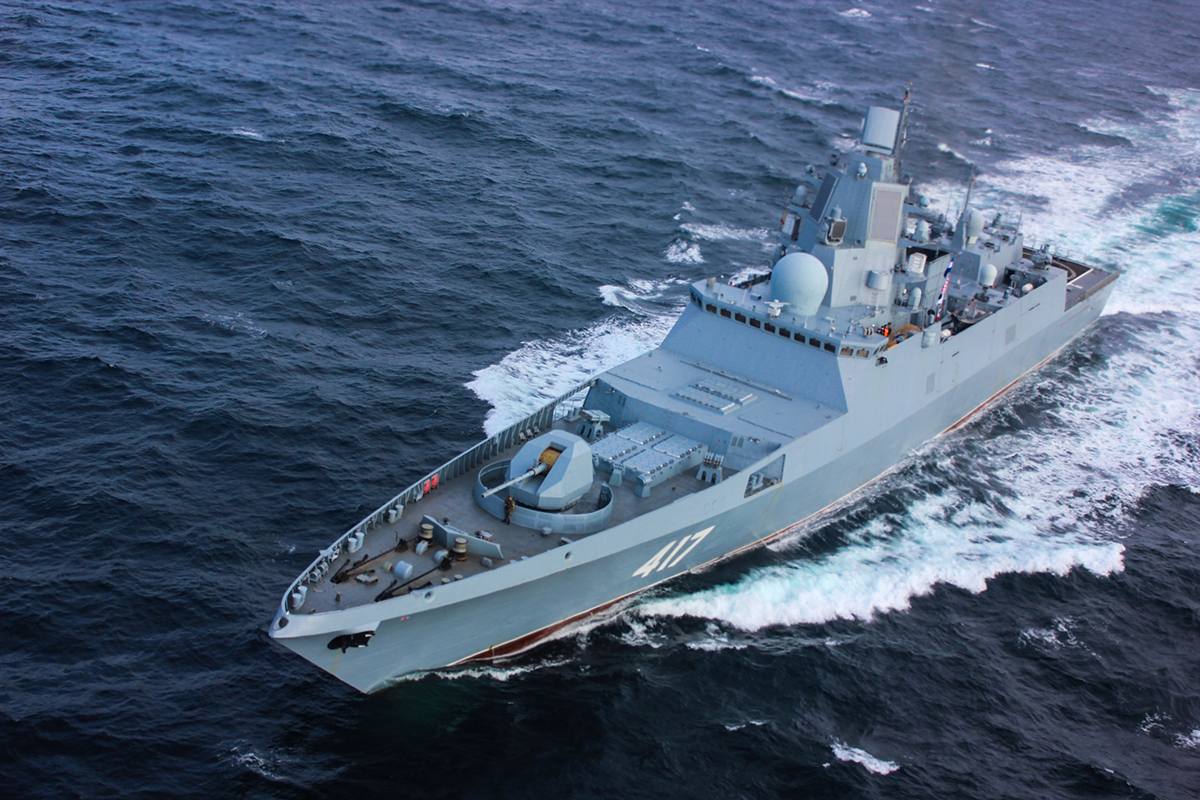The Russian Ministry of Defense (MoD) announced on January 9 that its recently flagged frigate Admiral Gorshkov, armed with hypersonic cruise weapons, held exercises in the Norwegian Sea.
“The crew of the frigate ‘Admiral of the Fleet of the Soviet Union Gorshkov’ conducted an air defense exercise in the Norwegian Sea,” the Ministry said. “The crew… conducted an exercise to repel the means of an air attack of a simulated enemy in the Norwegian Sea.” The MoD also released a video of the drills.
The crew of the vessel conducted exercises to rehearse repelling an air attack by a conventional enemy in the Norwegian Sea.
The drill predominantly focused on defending against enemy air attack weapons, aircraft, and anti-ship missiles and was conducted using a computer simulation of the tactical situation. Further, the drills reportedly included the conditional defeat of air targets by anti-aircraft fire weapons.
The crew of the frigate "Admiral Gorshkov" conducted exercises to repel an air attack by a conventional enemy in the Norwegian Sea in difficult hydrometeorological conditions. https://t.co/is1Ih40YHn pic.twitter.com/1fuw208KZ3
— Massimo Frantarelli (@MrFrantarelli) January 10, 2023
The MoD further stated that the calculations of the air defense command were accurate and met the requirements for maneuvering the ship.
The personnel working on combat detection and electronic and anti-aircraft fire destruction worked out the issuance and receipt of target designation and the conditional employment of a ship’s self-defense armament.
The Admiral Gorshkov class frigates are equipped with cruise missiles, a 130mm main cannon, the Redut navalized S-350 surface-to-air missile system, the Palash close-in weapon systems, and torpedoes.
In addition, it is fully loaded with anti-ship and land-attack versions of the Kalibr subsonic cruise missile family that have been extensively used against targets inside Ukraine.
The voyage of a detachment of ships, consisting of the frigate “Admiral of the Fleet of the Soviet Union Gorshkov” and the medium sea tanker “Kama,” is under the command of the commander of the division of missile ships of the Northern Fleet, Captain 1st Rank Oleg Gladly.
On January 4, the Russian frigate Admiral Gorshkov armed with the Zircon hypersonic missile, was flagged off by Defense Minister Sergei Shoigu to travel across the Atlantic Ocean, Indian Ocean, and the Mediterranean Sea.
#Russian frigate Admiral Gorshkov is sailing southwards along the coast of #Norway. She is legally in international waters – but as always, we are closely monitoring any movements and will do so as long as the frigate is in our areas. Photo taken from P-3 Orion today. #WeAreNATO pic.twitter.com/TRQvE6qlQQ
— Norwegian Armed Forces | Forsvaret (@Forsvaret_no) January 6, 2023
On January 6, the official handle of the Norwegian Armed Forces or Forsvaret informed in a tweet that “Russian frigate Admiral Gorshkov is sailing southwards along the coast of Norway. She is legally in international waters – but as always, we are closely monitoring any movements and will do so as long as the frigate is in our areas.”
The Forsvaret also released a photo of the vessel sailing in international waters that was reportedly taken by the P-3 Orion aircraft on the same day. The drills in the Norwegian Sea are significant as tensions are on the boil between Russia and Norway, which share a 198-kilometer border in the Arctic since Moscow launched the invasion of Ukraine.
Earlier, Norway declared in late October that it was raising the alert level for its military, reassigning additional people to operational responsibilities, and expanding the function of a rapid mobilization force. Norway’s chief of defense, Gen. Eirik Kristoffersen, said the country would also like to put its new fleet of P-8 Poseidon submarine-hunting maritime patrol aircraft into regular service sooner than anticipated.

Zircon-Armed Admiral Gorshkov’s First Far-Sea Voyage
This is the first time the vessel armed with hypersonic missiles has been put into operational duty. The ship also fired the Zircon hypersonic missile about 1,000 kilometers away in the Barents Sea. The multi-purpose hypersonic missile is designed to strike sea and ground targets and can travel at Mach 9 (11,113 kilometers per hour).
Earlier in 2020, Russia said Zircon had reached the mass manufacturing stage. The missile could evade even the most advanced American defenses. This was also recently observed by a German Publication, Frankfurter Rundschau.
The Admiral Gorshkov fires a Tsirkon pic.twitter.com/LBoB7Bhukw
— most definitely not the FSB (@defnotfsb) January 4, 2023
The article in the newspaper said, “For Western military strategists, hypersonic missiles are a nightmare. Unlike other missile systems, projectiles can still be controlled even after firing and reach speeds many times faster than sonic. This combination of controllability and speed makes them virtually invulnerable to anti-aircraft systems.”
For this reason, the voyage has been seen by Western military commentators as a subtle move by President Putin to project power. However, the Northern Fleet did not specify the number of Zircon hypersonic missiles the frigate carried on this voyage. After the Atlantic, the vessel is scheduled to enter the Indian Ocean and the Mediterranean Sea.
Besides the Zircon, the frigate is equipped with guided missiles and intended to handle deep sea and ocean issues.
When flagging the vessel for the voyage, Sergei Shoigu said the primary efforts during the campaign would focus on countering Russia’s threats and maintaining regional peace and stability together with friendly countries.” This may have been evident in the recent drills in the Norwegian Sea.
- Contact the author at sakshi.tiwari9555 (at) gmail.com
- Follow EurAsian Times on Google News




